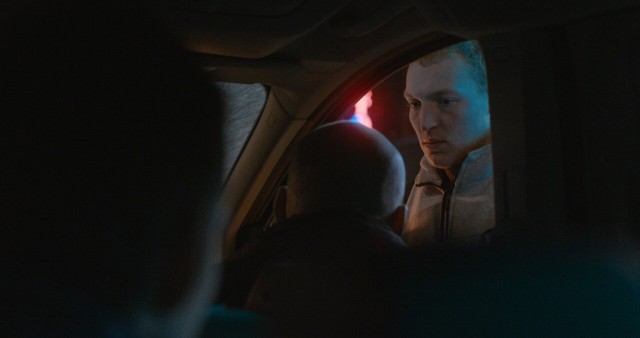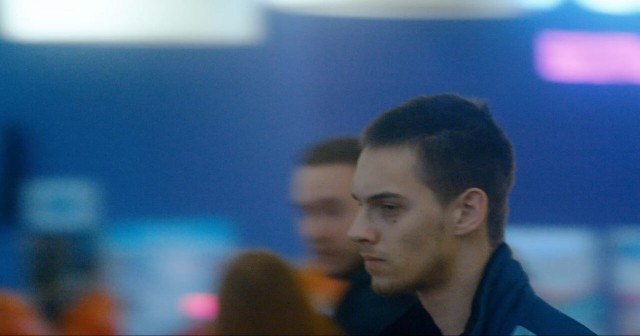There are only two brief scenes of dialogue in Fireworks. They are rather perfunctory exchanges and they bookend this remarkable and nearly wordless 18min film from Nikita Grushin. The first is an order—our protagonist, Oleg, a callow young man, repeats to his superior the process he is to follow in detonating an explosive device in a public space. The second is an invitation to order—a waitress lets Oleg know he can make requests at the bar and, with a great deal of thought, he asks for a cola. Both are simple dialogues and yet the symbolic journey by which our character moves from parroting instructions meant to cause destruction and chaos to choosing a simple and universal pleasure for himself is at the heart of Grushin’s film.
Fireworks begins in a van as it drives through a city on a blustery night. People exit the van and receive unheard instructions from a severe-looking man. Oleg is in the back, headphones on and playing games on his phone, but his time arrives too. Outside the passenger seat he recites the plan: enter the building…activate the device on command…blend in the with crowd, before heading into a shopping mall on his own. The setup fulfills Hitchcock’s famous quote about the bomb under the table—we know it’s there and now everything that follows is fascinating as we participate in this secret.
What follows is fascinating too, though perhaps not for the expected reasons. Despite the literal “ticking bomb” of its premise, Fireworks is less a taut thriller than a humanistic exercise in empathy. Adopting run-and-gun documentary-style techniques, Grushin employs a small crew in order to shoot surreptitiously in public spaces, while his DP, Ekaterina Smolina, utilizes a long lens to focus close on Oleg and present his POV. The collection of these shots, rather than mechanistically depicting the process of his mission, instead leans towards the impressionistic and sensory.
Long lenses “flatten” an image and create bokeh when opened up, and the film alternates between longer, voyeuristic shots that place Oleg within an active and busy sea of humanity—just one face among many—and intense close-ups that blur out the world around Oleg and focus on his perspective. Grushin chooses locations that are visually dynamic like an arcade, or a busy food court, and even in relatively static shots there is a whirl of light and color abstracted in the background, the points of lights reminiscent of the fireworks of the film’s title.
The effect is almost overwhelming. Oleg is, naturally, hypervigilant towards his surroundings due to the nature of his mission, but the sheer busyness of that focus risks sensory overload. Combined with the editing, the film builds to a sort of paranoid panic, as we sink deeper into Oleg’s rhythm and experience his stress. And yet the content of that sensory overload is key—when the movement stops and Oleg’s focus is set, it is usually on…faces. Dozens of ordinary people. Are they a threat? Do they know what he is about to do? That may be the impetus for his gaze, but in practice what it does is open Oleg up to moments of beauty—a stray touch of affection across a loved one’s face, a child and their mother, a dog’s pure love. Does Oleg want to destroy this?
The film was inspired by real events—in 2017 Grushin was nearby when a 22-year-old exploded a device in the St. Petersburg metro, killing 15. It was the first time terrorism had made itself present as an aspect of his life and the fascination persisted throughout time, leading to this film. However, Fireworks can, based on your perspective, be accused of naivete—Grushin’s desire to humanize his perpetrator while at the same time deliberately removing politics from what is, ultimately, a deeply political act, is an idealized portrait shorn of necessary specificity. I don’t mind the decision though. With its ambiguous end, the film is hardly manipulative, and I find its humanistic message of grace uplifting and effective. As Grushin relates to us, “…no matter how confused a person is in his life, he should have a chance to be saved.”
Grushin, a graduate of the directing workshop at the St. Petersburg School of New Cinema and the scenario workshop at the Moscow School of New Cinema, now teaches at the School of New Cinema. With several short films under his belt, including The Last Word and Alice’s One Day, the director is focusing on feature-length projects now and is preparing to shoot his first—a film about Russian poachers who mine amber. Good luck to Grushin, as he continues to push forward with his art, we’ll be watching!

 Jason Sondhi
Jason Sondhi

